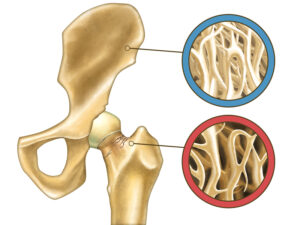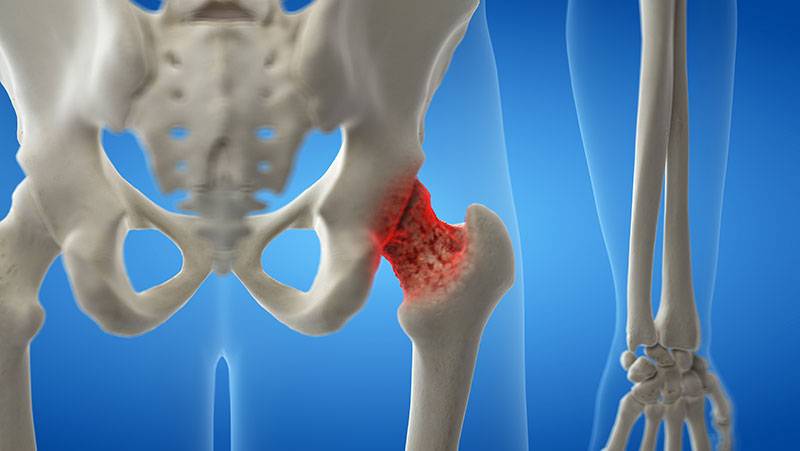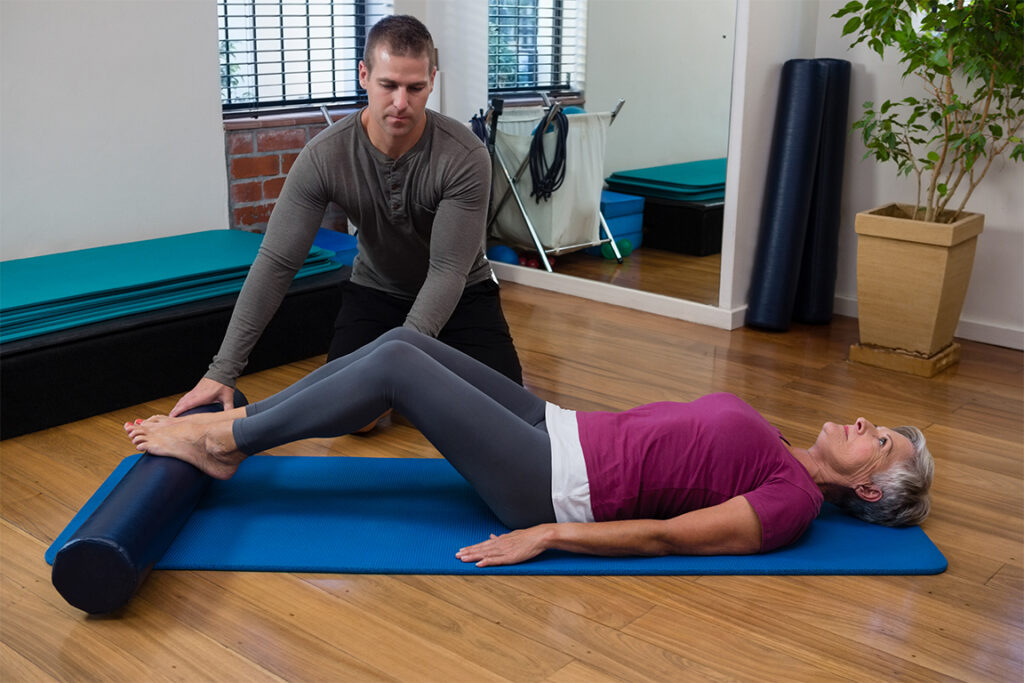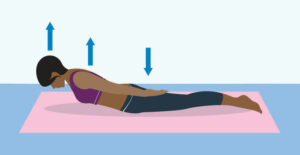Osteopenia is a condition characterized by low bone mass and structural deterioration of bone tissue. It’s often diagnosed when a person has a bone mineral density (BMD) test that falls below normal levels. There is no one-size-fits-all approach to osteopenia treatment. The goal of therapy is to prevent the condition from progressing to osteoporosis and to reduce the risk of fractures. Physical therapy can play an important role in achieving these goals. In this blog, we’ll provide you with a comprehensive overview of physical therapy for osteopenia and discuss some common exercises and protocols.
Contents
What Is Osteopenia?

Osteopenia is a condition in which bone density is decreased and the bones are more fragile. This can lead to an increased risk of fractures, especially in the hip, wrist, and spine. Osteopenia is often caused by a lack of calcium and vitamin D in the diet.
Osteopenia is also a precursor to osteoporosis, a condition in which bones become weak and brittle. Osteoporosis can lead to fractures and other serious health problems. Sometimes, osteopenia is a sign of an underlying health problem, such as an illness or hormonal imbalance, and may need to be treated.
There are many treatment methods available for osteopenia, including diet and exercise. Some medications, such as bisphosphonates, can also improve bone density. Other treatment methods that are useful for osteoporosis include physical therapy.
Physical Therapy Guide to Osteopenia
Physical therapy is one of the most important treatment methods for osteopenia. Also, Physical therapy can help prevent the condition from progressing to osteoporosis and can reduce the risk of fractures. People may prefer to see a physical therapist who specializes in treating osteoporosis, but physical therapy is also useful for treating osteopenia.
Physical therapy can help improve strength, flexibility, balance, and endurance. It can also help people improve their breathing and circulation. In addition, physical therapy can help people learn how to use their muscles safely and effectively.
Physical therapy is a combination of exercises and treatments that are tailored to the individual’s needs. Treatment may include:
-Exercises that are designed to increase bone density and improve structural stability
-Treatments that increase blood flow and improve joint movement
-Counseling to help people make healthy lifestyle choices
Physical therapy is an important part of the treatment for osteopenia. If you are experiencing symptoms of osteopenia, it is important to see a doctor and speak about your options for treatment.
Types of Physical Therapy Guide For Osteopenia

Many types of physical therapy can be used to treat osteopenia. These therapies may include:
Resistance Exercise
One of the most common types of physical therapy used to treat osteopenia is resistance exercise. Resistance exercise helps to increase the strength and size of skeletal muscles. This can help to improve the function of the skeletal system and increase bone density. Resistance exercise can be done using a variety of methods, including:
Weightlifting: One of the most common types of resistance exercise, weightlifting involves lifting weights using your muscles. Weightlifting can be done with free weights, weight machines, or barbells.
Cardiovascular Exercise: Cardiovascular exercise helps to improve your heart health and increase your overall fitness level. Cardiovascular exercise can be done using a variety of methods, including running, jogging, biking, swimming, and rowing.
Resistance Band Exercises: Resistance band exercises are another type of resistance exercise that is often used in conjunction with other forms of physical therapy. Resistance band exercises involve using a band to resist the movement of your joints. This type of exercise is often used to improve joint function and reduce pain.
Skeletal Muscle Electrical Stimulation (SMEs): Skeletal muscle electrical stimulation is a type of resistance exercise that uses electrical currents to stimulate the growth and strength of skeletal muscles.
Manual Therapy

Manual therapy is a type of physical therapy that uses manual methods to improve function in the body. Also, Manual therapy is used to treat a variety of conditions, including osteopenia. Manual therapy can help improve the range of motion, strength, and flexibility of the joints. It can also help reduce pain and inflammation.
Manual therapy can be conducted on a variety of areas, including the neck, back, shoulders, hips, knees, and feet. The therapist will often use a variety of techniques, such as stretches, pressure points, and finger exercises. In general, manual therapy is most effective when it is combined with other treatments such as osteoporosis medication or surgery.
Exercise Therapy
Exercise is one of the most common forms of physical therapy, and for good reason: it works! Studies have shown that regular exercise can help increase bone density and decrease the risk of fractures. The most important thing to remember when starting an exercise program is to gradually add more intensity and duration over time.
Occupational Therapy
Occupational therapy is another type of physical therapy that is often used to help people with osteopenia. This type of therapy focuses on helping people with osteopenia find new ways to use their muscles and bones to improve their overall physical health.
Occupational therapy can help people with osteopenia learn how to do tasks such as bathing and dressing, as well as perform simple exercises such as balancing on one leg or walking.
Hydrotherapy

One of the most common types of physical therapy for osteopenia is hydrotherapy. This type of therapy uses water to help improve the bone health of people with osteopenia by increasing the density and strength of their bones. Hydrotherapy can be done in a variety of ways, including bath therapy, shower therapy, and spa therapy.
This type of therapy is also a good way to relieve stress and tension from the body, which can help improve the bone health of people with osteopenia.
Chiropractic Care
Another type of physical therapy that can be used to help people with osteopenia is chiropractic care. Chiropractic care focuses on the use of spinal adjustments and other chiropractic treatments to improve the overall health of people’s bones.
Chiropractic care is effective in helping to improve the bone health of people with osteopenia, and it is a safe type of treatment that does not require any medications or surgery.
This may be helpful for you.
Acupuncture
There are many types of acupuncture, each with its specific benefits. Here are just a few:
Acupuncture and Tui Na: Acupuncture uses sterile needles to stimulate specific points on the body. Tui Na, or Chinese massage, is a type of acupuncture that uses pressure and strokes along the meridians to promote relaxation and healing.
Acupuncture and Traditional Chinese Medicine: Acupuncture is often used in combination with Chinese medicine treatments, which use herbs and other treatments to restore balance in the body. Also, Acupuncture can help improve circulation, relieve pain, and boost the immune system.
Acupuncture for Chronic Pain: Acupuncture is effective in treating chronic pain conditions such as fibromyalgia and tension headaches. By addressing the root cause of the pain, acupuncture can provide relief for a longer period than traditional medications.
Yoga
Many types of yoga can be beneficial for people with osteopenia. In particular, Iyengar and Hatha yoga are two popular types of yoga that can help improve flexibility, balance, and postural awareness. Yoga also helps to increase energy levels and promote restful sleep.
In addition, yoga can improve muscle strength and function, leading to improved mobility and quality of life.
Yoga can be performed individually or in a group setting. It is important to speak with your physical therapist about what type of yoga may be best suited for you based on your condition and needs.
Why Do People Choose Physical Therapy For Osteopenia?

There are several reasons why people may choose physical therapy for osteopenia. Some of these reasons for osteopenia treatment may include:
Reduced bone density or strength
This is the first reason why people would seek out physical therapy for osteopenia. If bone density or strength is reduced, then the individual may experience more difficulty with everyday activities such as climbing stairs or lifting objects. Physical therapy can help to improve bone density and strength by increasing bone mass and muscle activity.
Improved joint function
If the joint function is poor, then it can lead to increased pain and inflammation in the surrounding area. Physical therapy can help improve joint function by providing exercises that stretch and strengthen the surrounding muscles and connective tissues. This can help to reduce pain and inflammation and improve the overall quality of life.
Reduced risk of osteoporosis
Osteoporosis is a disease in which bones become thin and brittle. If left untreated, osteoporosis can lead to fractures, which can be very painful and difficult to heal. Physical therapy can help to reduce the risk of osteoporosis by improving strength and mobility, which can help to protect bones from breaking down.
Improved Effectivity
Another reason why people may choose physical therapy for osteopenia is because of the effectiveness of the treatments. Many studies have shown that physical therapy is one of the most effective methods for improving bone density and muscle function in patients with osteopenia.
Reduced Cost
One such thing that physical therapy can do is to reduce the cost of care. Physical therapy can provide several complimentary services such as exercise guidance, education, and counseling. This can help to reduce the overall cost of care and make it more affordable for patients.
How To Prepare for Physical Therapy For Osteopenia?

If you are seeking physical therapy to treat osteopenia, there are a few things you can do to prepare for your first session.
First, it is important to consult with your doctor to get clearance for physical activity. Once you have been cleared, you should dress in comfortable clothing that allows you freedom of movement. You may also want to bring a water bottle and a small snack in case you need energy during or after your session.
Most importantly, be prepared to actively participate in your therapy sessions. This means being ready to listen to and follow the instructions of your therapist. Trust that your therapist has the experience and expertise necessary to help you achieve your rehabilitation goals.
If at any time you feel pain or discomfort, be sure to communicate this to your therapist immediately. With proper preparation and participation, physical therapy can be an excellent treatment option for osteopenia.
Another tip for how to prepare for physical therapy for osteopenia is to schedule a consultation with a therapist near you. This will help you determine if physical therapy is right for you and ensure that you are prepared for your first session.
Conclusion
Osteopenia is a condition in which your bones have lost some volume and density. This can lead to fractures, especially if the osteopenia is severe. If you are experiencing any of the following symptoms, you must see a therapist and get started on treatment: pain when you move your joints, difficulty walking or climbing stairs, a decrease in bone mineral density (BMD), and an increase in the number of new bone lesions. The sooner you start treatment, the better your chances are for minimizing fractures and improving your overall quality of life.
We hope that this guide has given you a better understanding of osteopenia and how physical therapy can help. If you think you may be suffering from osteopenia, or if you have any other concerns about your bone health, please consult with a doctor or certified physical therapist to get expert advice.
Physical Therapy help patients recover from pain. If you’re experiencing Back pain, Shoulder pain, Knee pain, Neck pain, Elbow pain, Hip pain, or Arthritis pain, a physical therapist at MantraCare can help: Book a physiotherapy session.


